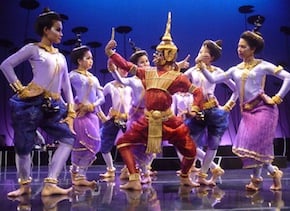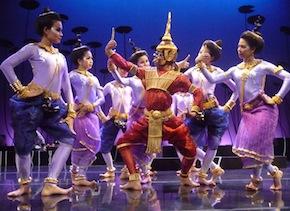Sohpiline Cheam Shapiro set out to change the world. Nearly a decade later, that’s precisely what she is doing. The wide impact of her passion will be felt at Zellerbach Hall on Oct. 2 when Cambodia’s Khmer Arts Ensemble takes the stage.

Shapiro saw a great need to enhance Cambodia’s culture and presence in the world. She decided to attempt this through a two-pronged approach. In 2002 she established the Khmer Arts Academy, which provides a space for both traditional and new art to flourish. Guided by great masters of Cambodian dance, the students help to preserve and promote the ancient art form. The tradition is daily pushed beyond its original intent by expanding the repertoire to reflect present-day concerns. This modern stretch of the traditional dance is made easier through the location of one center in Cambodia, and the other in Long Beach, California.
The mystery and power of Cambodian traditional dance is brought to the cultural forefront through the Khmer Arts Ensemble, which tours the world. Shapiro is dedicated to creating new and relevant work in the classical style of dance. She strives to have every story she creates answer the myriad questions surrounding Cambodian history and culture. Her latest work, The Lives of Giants, is no different. The work delves into the world of Reamker, the Cambodian version of Ramayana. Shapiro explores its never-ending cycle of abuse and power as demonstrated through the giant Khameaso. Ridiculed all his life for being different, Khameaso quickly learns the perils of power as he rises above his aggressors. “How can we break that cycle?” Shapiro asks. “People can always find a reason to look down on others. ... That leads into a cycle of abuse, a cycle of revenge that will never end.”
The story further explores the cycle by questioning the leaders in this heavenly setting. Which leader is stronger: the one who leads in the moment, the one who leads by force, or the one who leads by compassion? Shapiro sees the impact of this theme in daily life, specifically the view of children with regard to their parents. “They see the advice of their parents as restricting, and taking away their freedom.” She adds that children will continue to rebel against their parents until the children can fully understand their actions.
Lives of Giants is a visual wonder due to the innovative mix of both Cambodian and American collaborators. The story is set at the bottom of a lily pond, inspired by the actual pond in front of the Ensemble’s rehearsal space. The costumes are a combination of American materials with Cambodian design. The musicians will don black lily pads as they create and enhance the scene. The dancers meld traditional technique with a new form to reflect the pain and suffering of the characters. Even the giant’s mask melds the traditional form with contemporary materials. Shapiro hopes that Bay Area audiences will experience in this cutting-edge piece a form of classical dance viewed through the lens of a contemporary sensibility. “It is quite stunning,” she remarks. “I am really proud of this production.”

